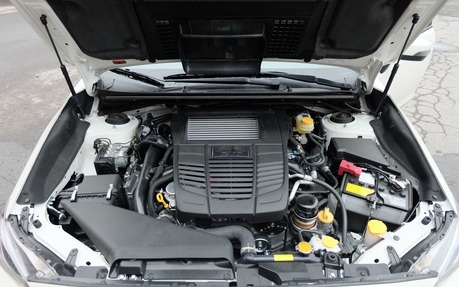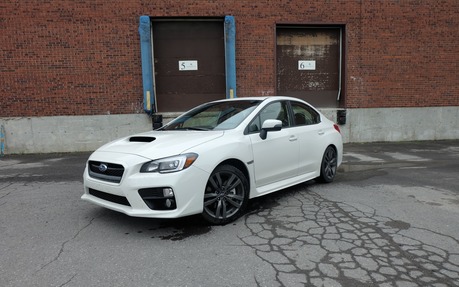2016 Subaru WRX: Held Back
The sporty compact segment was thriving a few years ago, as the Chevrolet Cobalt SS and the Dodge Caliber SRT4 were duking it out on the American front, while the Mazdaspeed3, the Honda Civic Si and the Volkswagen Golf GTI were the big players to bring down. Today, sales aren't as good as they used to be. Some of these competitors died out like the aforementioned Mazda, Chevy and Dodge, while buyers seem to have moved upmarket. Today, the spotlight is on the Golf R, the Ford Focus RS and the Subaru WRX STI.
This leaves the STI's little brother, the WRX, in an awkward position. When the legendary rally racer was redone for 2014, it severed its ties with the standard Impreza. Back in the days, its 268 horsepower would have been enough to make it the top dog. Today however, some might see it as too tame, too sedated.
And that couldn't be further away from the truth.
The everyday racer
First of all, let's be frank: the 2016 Subaru WRX isn't the most comfortable daily driver on the market. It’s loud, it’s brash, and the interior quality is typical of Subaru products with some cheap-looking plastics and a somewhat dull presentation. The infotainment system is laggy, sometimes unresponsive and infuriating to use. The sound system’s bass output is great, but that's about it. Finally, the seats aren't the most padded, and their bolsters might not fit larger drivers.
However, you don't buy a WRX for its comfort or its interior quality. You are considering this car either because you fell in love with Subaru's all-wheel drive system and want something sportier than a Forester or a Legacy, or you are in the market for a year-round race car with license plates on it. And the WRX is perfect for those two scenarios.

Under the large hood scoop of the sedan sits a top-mounted intercooler. Under that is a turbocharged, 2.0-litre flat-four engine developing the aforementioned 268 ponies at 5600 rpm. That might be only three horsepower more than the last generation's 2.5-litre, EJ-series engine, but torque is where things get interesting: while the old WRX made 244 pound-feet at 4000 rpm, the new, smaller four-cylinder makes 258 pound-feet at 2000 rpm. This makes for a less peaky engine with more grunt throughout the rev range.
There is some noticeable turbo lag when you floor the accelerator, but it doesn't really detract from the driving experience: if anything, it adds a layer of fun when you have to gauge when the boost is going to come on while throwing the car into a turn.
The only thing I could say against this engine is that it almost feels like it is held back: when the power comes on, it's not as brutal as I would have expected. Maybe I'm used to the violent delivery of a peaky turbo, but the WRX's 2.0-litre mill almost feels like it could do a lot more with just a little more boost... Maybe it was engineered this way so as not to overshadow the STI?
Our tester came with a six-speed manual transmission; while it doesn't have the precision of a Mazda or Honda gearbox, the lever is notchy and the throws are short. The clutch has limited travel, too. In the right hands and with a little practice, this gearbox works flawlessly and can make the driver feel like a rally driver. There is also a CVT offered, but... you know…
You pay for AWD... and performance
At a starting price of $31,760, the 2016 Subaru WRX is more expensive than its rivals, namely the GTI and the Ford Focus ST. However, it’s quicker than both of them, especially if there is snow or water on the ground. If you want some amenities, like a sunroof and a power driver’s seat, you will have to go for the WRX Sport at $34,560. Finally, the WRX Sport-tech like the white sedan we tested will give you a seven-inch infotainment screen with navigation, leather seats, pushbutton start and 18-inch Enkei wheels, among other things. It retails for 37,860.
Yes, buying a WRX means you will have to live with a somewhat harsh suspension and a lacklustre interior, but if you want a competent year-round sports car that will enable you to live your rally fantasies, there aren't really any other options.
| Test drive report | |
| Test model | 2017 Subaru WRX |
|---|---|
| Trim level | Sedan Sport-tech |
| Price range | $29,995 – $45,395 |
| Price as tested | 36 095 $ |
| Warranty (basic) | 3 years/60,000 km |
| Warranty (powertrain) | 5 years/100,000 km |
| Fuel economy (city/highway/observed) | 11,3 / 8,5 / 9,5 L/100km |
| Options | N/A |
| Competitive models | Mercedes-Benz CLA, Mitsubishi Lancer |
| Strong points |
|
| Weak points |
|
| Editor's rating | |
| Fuel economy | If you can keep out of the engine's turbo boost, it's really not that bad... |
| Comfort | Not the most comfortable cockpit, and the interior quality is sub-par. |
| Performance | The 2.0-litre engine is torquey and has ample power everywhere through the rev range. |
| Infotainment | Apart from the fact that the infotainment system is laggy, the sound system is nothing to write home about. |
| Driving | Subaru knows how to make a vehicle feel like a rally car: the shifter has a short throw, the clutch is heavy and the steering is direct. |
| Overall | On its own, the WRX is a really fun car. However, as a daily driver, it has its flaws. Still, you probably won't mind most of them when you are barreling sideways down a dirt road while living your Ken Block fantasies... |
